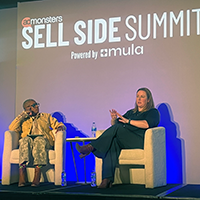Here are two truths about trend-spotting: It’s not rocket science. And everyone should do it.
“You have to look a little further ahead to stay in business,” says Jay Lenstrom, president of GMR Marketing, New Berlin, WI. “Some [marketers] are willing to take some risk; others need four years of documented research before moving ahead. They all succeed in their own way.”
GMR employs more than 1,000 field marketers who keep their ears to the rail in 50 markets overall but especially in “trend corridors” (think New York City and Miami on the East Coast, L.A. and San Francisco out West, Chicago and Dallas in between). It’s part of their jobs to watch for new trends.
Twice a month or so, field reps get an e-mail asking for 24- to 48-hour snapshots of their city for a specific client. They go to edgy neighborhoods to talk with and photograph the hippest-looking folks on the street, shop hot stores, and gather as many artifacts as possible to ship to headquarters.
“If you had the luxury of traveling across the country for a month, you’d see all these things,” Lenstrom says. “But marketers don’t have that luxury.”
Clients ask for information on their brands, competitors, and “non-competitive lifestyle categories” like music, fashion, and electronics. “The cell phone, shoes, candy bar, and soft drink a teen chooses are all linked somehow,” says Lenstrom.
“The cell phone, shoes, candy bar, and soft drink a teen chooses are all linked somehow.”
— Jay Lenstrom, GMR Marketing
While some trend-spotters fixate on teen styles, marketers are also looking for insight into multicultural cities, Latinos, college students, and adults under 34 — what Lenstrom calls “influence groups” that start and spread trends. “Once we’re married and parents, we’re less influential,” he laughs.
Street intelligence is in heaviest demand in May, June, and July, as marketers finalize next-year planning, and in August, when a new crop of consumers hit college and high school campuses. GMR synthesizes info and turns around reports in two days, thanks to cell phones, laptops, and digital cameras.
Research firm Yodawobe Co., Wilton, CT, this summer launched Eventmax to track sponsors’ ROI on events. Attendees get a questionnaire with sweeps entries (coded by event location) and coupons. Marketers can ask demographic, lifestyle, or product-use questions; a searchable database is posted on a password-protected Web site within 48 hours. Golf Magazine Properties set a test at the Sybase Big Apple Classic in late July and at LPGA events earlier this year.
Eavesdropping Online
Pillsbury watches conversations among consumers on the Mealtime Ideas bulletin board at Pillsbury.com. At-home chefs ask each other’s advice on coconut (flaked or shredded?), raspberry iced tea recipes (strained berries vs. juice), and hunting up old recipes (Mexican pizza: “It was a glossy insert from a flour bag.”)
“It’s like neighbors chatting over the back fence,” says Liz Petrangelo, principal of Pillsbury shop Creative Resource Center, Eden Prairie, MN (see sidebar, pg. 32). “You really hear what they think about food in general.”
Consumers are unfazed that Pillsbury reviews their comments before posting, so Pillsbury feels comfortable analyzing the postings in aggregate to spot food trends (like “homemade weddings”) and improve its site. (When too many chefs asked the same questions, CRC improved the search function.)
Trend-spotting is good for employee morale, too. GMR’s field reps “feel like they’re part of the info chain back to corporate America in a cool way,” says Lenstrom. “They’re not like the people with a clipboard at the airport. It’s more a friendship exchange than a survey.”
So get out there and make some new friends.
Stealth and the Store Check
When Pillsbury and its agency, Creative Resource Center, cruised a Haagen-Dazs Shop in June to see how its Dazzler introduction was playing, PROMO tagged along.
Discover the Dazzler marries in-store displays with an online sweeps. Shop customers get game cards with PINs they enter at haagen-dazs.com to receive a virtual “scratch-off” card; players click to match three icons to win a Jaguar, a $5,000 shopping spree, a year’s supply of ice cream, or a free Dazzler (a vanilla ice cream-and-fresh-fruit sundae). Minneapolis-based Pillsbury’s Haagen-Dazs unit developed the campaign to stir its franchisees, who own 230 shops in the U.S.
CRC staffers met at a Minneapolis shop to see how P-O-P (counter cards, menu boards, and a sidewalk banner) was displayed, if counter crews handed out gamepieces with each purchase, and — since it was lunchtime — find out what the Dazzler tastes like. “Everything is set up how I wanted it,” says Haagen-Dazs Shops marketing manager Kelly Wold.
The dozen agency workers were a conspicuous crew. PROMO was not surprised that they got impeccable service. “Shouldn’t a store check be more anonymous?” we asked. “I did a sneaky last week,” admits Joe Andrews, CRC vp-integrated marketing. “This gathering was also to celebrate the campaign kick-off.”
The week after the campaign’s coupon drop, Wold called at least 20 shops to see how the sweeps was playing. (About 10 percent formally track redemption.) CRC monitors the Web site daily to track the number of game cards distributed, number of winners, and which prizes have been won. Game cards ship in two batches: the first based on store volume, the second adjusted by franchisee need.
Pillsbury considers such follow-up part of agency service, but sends its own reps too — a dozen or so franchise business managers who are familiar faces in the 25 stores each oversees, but also incognito visitors from headquarters.
CRC exec vp Liz Petrangelo says store checks are usually much less obvious than this ice cream social. Supermarket checks are the toughest: “You’ll get wrestled to the ground if they see you taking pictures of the shelves.” (For a closer look at store checks, see Channels.)
Spot-checking in-store demos is best done anonymously “so you can see how they treat you,” Andrews advises. “We try to give demonstrators three points of information and hope they get one” across to consumers.
If they’re serving tasty snacks, PROMO is happy to come along.



